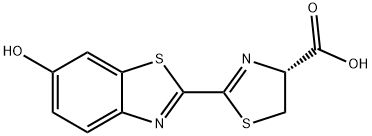D-Luciferin sodium salt
Synonym(s):(S)-2-(6-Hydroxy-2-benzothiazolyl)-2-thiazoline-4-carboxylic acid sodium salt;4,5-Dihydro-2-(6-hydroxy-2-benzothiazolyl)-4-thiazolecarboxylic acid sodium salt;Firefly luciferin sodium salt
- CAS NO.:103404-75-7
- Empirical Formula: C11H9N2NaO3S2
- Molecular Weight: 304.31
- MDL number: MFCD00044938
- EINECS: 600-430-4
- SAFETY DATA SHEET (SDS)
- Update Date: 2024-11-19 23:02:33

What is D-Luciferin sodium salt?
Description
D-
Chemical properties
Yellow powder
The Uses of D-Luciferin sodium salt
D-Luciferin sodium salt is substrate for firefly luciferase, properties and use in assays of ATP and luciferase.
The Uses of D-Luciferin sodium salt
Luciferin is used for luciferase assays and determination of ATP.
The Uses of D-Luciferin sodium salt
D-Luciferin sodium salt has been used as a substrate in luciferin?luciferase chemiluminescence assay to determine ATP levels.
What are the applications of Application
D-Luciferin sodium salt is a substrate that produces bioluminescence upon oxidation by the enzyme luciferase
What are the applications of Application
D-Luciferin, sodium salt monohydrate is a bioluminescent compound
General Description
D-Luciferin is mainly produced in bioluminescent organisms. It can simply circulate across the blood testis barrier, blood brain barrier and the blood placenta barrier. This small molecule is sensitive to light and oxygen. D-Luciferin is also sensitive to moisture in its powder form.
Biological Activity
D-Luciferin sodium salt is a firefly luciferase substrate (Km = ~2 μM). Used in much standard bioluminescence imaging (BLI) techniques, including monitoring tumor growth and investigating intracellular signaling activity in vitro and in vivo. Cell permeable. Emission maximum = 562 nm.
storage
-20°C
Properties of D-Luciferin sodium salt
| storage temp. | -20°C |
| solubility | H2O: soluble |
| form | lyophilized powder |
| color | Yellow |
| InChI | InChI=1/C11H8N2O3S2.Na.H/c14-5-1-2-6-8(3-5)18-10(12-6)9-13-7(4-17-9)11(15)16;;/h1-3,7,14H,4H2,(H,15,16);;/t7-;;/s3 |
| CAS DataBase Reference | 103404-75-7(CAS DataBase Reference) |
Safety information for D-Luciferin sodium salt
Computed Descriptors for D-Luciferin sodium salt
| InChIKey | ZONJDNKUJJUQCK-DCFBZVEJNA-N |
| SMILES | C([C@H]1CSC(C2=NC3C=CC(O)=CC=3S2)=N1)(=O)O.[NaH] |&1:1,r| |
D-Luciferin sodium salt manufacturer
Inventichem
New Products
(S)-3-Aminobutanenitrile hydrochloride 4-Methylphenylacetic acid N-Boc-D-alaninol N-BOC-D/L-ALANINOL Tert-butyl bis(2-chloroethyl)carbamate 3-Morpholino-1-(4-nitrophenyl)-5,6-dihydropyridin- 2(1H)-one Furan-2,5-Dicarboxylic Acid Tropic acid 1-Bromo-3,5-Di-Tert-Butylbenzene S-2-CHLORO PROPIONIC ACID ETHYL ISOCYANOACETATE 2-Bromo-1,3-Bis(Dimethylamino)Trimethinium Hexafluorophosphate 4-IODO BENZOIC ACID 3-NITRO-2-METHYL ANILINE 1-(2,4-DICHLOROPHENYL) ETHANAMINE (2-Hydroxyphenyl)acetonitrile 4-Bromopyrazole 2-(Cyanocyclohexyl)acetic acid 4-methoxy-3,5-dinitropyridine 1-(4-(aminomethyl)benzyl)urea hydrochloride 2-aminopropyl benzoate hydrochloride diethyl 2-(2-((tertbutoxycarbonyl)amino) ethyl)malonate tert-butyl 4- (ureidomethyl)benzylcarbamate Ethyl-2-chloro((4-methoxyphenyl)hydrazono)acetateRelated products of tetrahydrofuran








You may like
-
 103404-75-7 D-Luciferin sodium salt 98%View Details
103404-75-7 D-Luciferin sodium salt 98%View Details
103404-75-7 -
 D-Luciferin sodium salt 95% CAS 103404-75-7View Details
D-Luciferin sodium salt 95% CAS 103404-75-7View Details
103404-75-7 -
 D-Luciferin sodium salt CAS 103404-75-7View Details
D-Luciferin sodium salt CAS 103404-75-7View Details
103404-75-7 -
 1975-50-4 98%View Details
1975-50-4 98%View Details
1975-50-4 -
 2-HYDROXY BENZYL ALCOHOL 98%View Details
2-HYDROXY BENZYL ALCOHOL 98%View Details
90-01-7 -
 2-Chloro-1,3-Bis(Dimethylamino)Trimethinium Hexafluorophosphate 221615-75-4 98%View Details
2-Chloro-1,3-Bis(Dimethylamino)Trimethinium Hexafluorophosphate 221615-75-4 98%View Details
221615-75-4 -
 14714-50-2 (2-Hydroxyphenyl)acetonitrile 98+View Details
14714-50-2 (2-Hydroxyphenyl)acetonitrile 98+View Details
14714-50-2 -
 118753-70-1 98+View Details
118753-70-1 98+View Details
118753-70-1